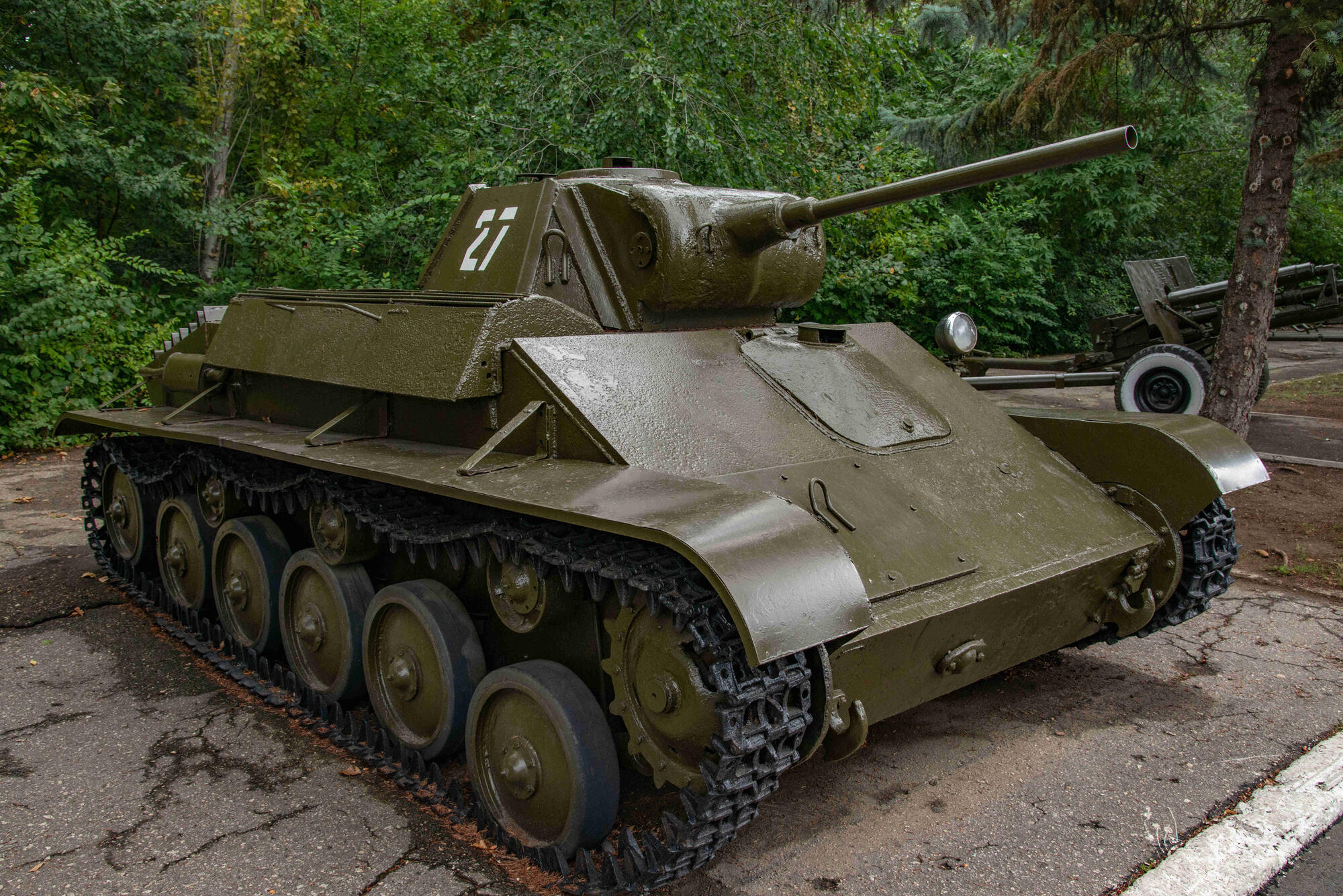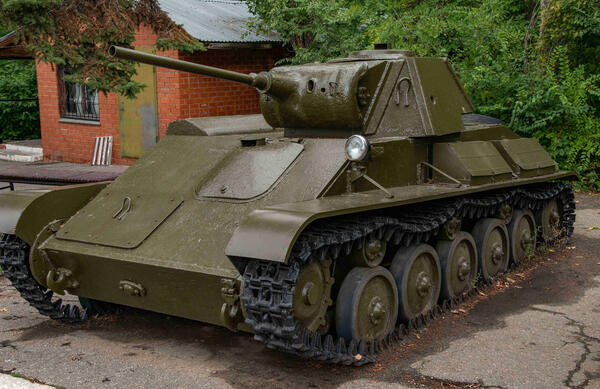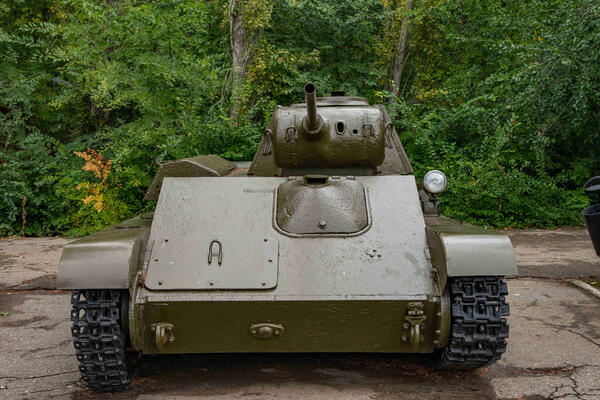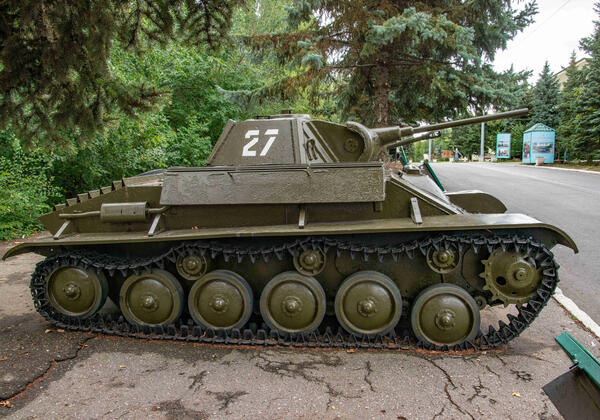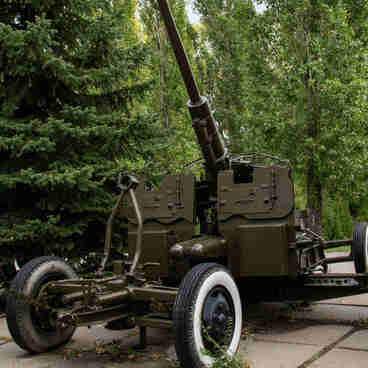The T-70 light tank was developed on the basis of the T-60 tank in the design bureau of the Gorky Automobile Plant under the leadership of Nikolay Alexandrovich Astrov. It entered service in 1942.
The tank had the driving compartment in the front part of the hull, the fighting compartment in the middle part, and the stern compartment. To the right in the driving direction, it had the transmission compartment in the front, and the engine compartment in the middle.
The crew of two soldiers was housed in the hull and the turret. The driver-mechanic was in the bow of the hull on the left side. The tank commander was stationed in the rotating turret, which was shifted to the left side. In the middle part of the hull, two engines paired consequentially were mounted on one shared frame. They formed a single power unit.
The vehicle had a front wheel-drive layout with the transmission at the front of the hull. The tank was protected with armor 15–45 mm thick and was armed with a 45mm cannon and a 7.62mm machine gun. Two fuel tanks with a total capacity of 440 liters were placed in the left part of the stern compartment in a section isolated by armored panels.
In September 1942, factories started to produce the T-70M version. The width of the tracks was increased from 260 to 300 mm. The track pitch, the width of the return rollers, the diameter of the suspension torsion bars and the cogs of the drive wheels were increased as well. The number of tracks in the caterpillar tread was reduced from 91 to 80.
The modernized combat vehicle was also reinforced with return rollers, brakes and final reduction gear units. A number of other minor changes were made, in particular, the vision port on the driver’s hatch was replaced with a periscope viewing device, the ammunition stowage of the gun was reduced to 70 rounds. All tanks could be fitted with a radio station.
As a result, the weight of the tank increased to 10 tons. The T-70M tanks were used as prototypes for the T-80 light tank and a number of self-propelled artillery vehicles. In total, more than 8 thousand units were manufactured. The T-70 light tanks were used in the Battles of Stalingrad and Kursk, as well as other operations of the Great Patriotic War.
The tank had the driving compartment in the front part of the hull, the fighting compartment in the middle part, and the stern compartment. To the right in the driving direction, it had the transmission compartment in the front, and the engine compartment in the middle.
The crew of two soldiers was housed in the hull and the turret. The driver-mechanic was in the bow of the hull on the left side. The tank commander was stationed in the rotating turret, which was shifted to the left side. In the middle part of the hull, two engines paired consequentially were mounted on one shared frame. They formed a single power unit.
The vehicle had a front wheel-drive layout with the transmission at the front of the hull. The tank was protected with armor 15–45 mm thick and was armed with a 45mm cannon and a 7.62mm machine gun. Two fuel tanks with a total capacity of 440 liters were placed in the left part of the stern compartment in a section isolated by armored panels.
In September 1942, factories started to produce the T-70M version. The width of the tracks was increased from 260 to 300 mm. The track pitch, the width of the return rollers, the diameter of the suspension torsion bars and the cogs of the drive wheels were increased as well. The number of tracks in the caterpillar tread was reduced from 91 to 80.
The modernized combat vehicle was also reinforced with return rollers, brakes and final reduction gear units. A number of other minor changes were made, in particular, the vision port on the driver’s hatch was replaced with a periscope viewing device, the ammunition stowage of the gun was reduced to 70 rounds. All tanks could be fitted with a radio station.
As a result, the weight of the tank increased to 10 tons. The T-70M tanks were used as prototypes for the T-80 light tank and a number of self-propelled artillery vehicles. In total, more than 8 thousand units were manufactured. The T-70 light tanks were used in the Battles of Stalingrad and Kursk, as well as other operations of the Great Patriotic War.
